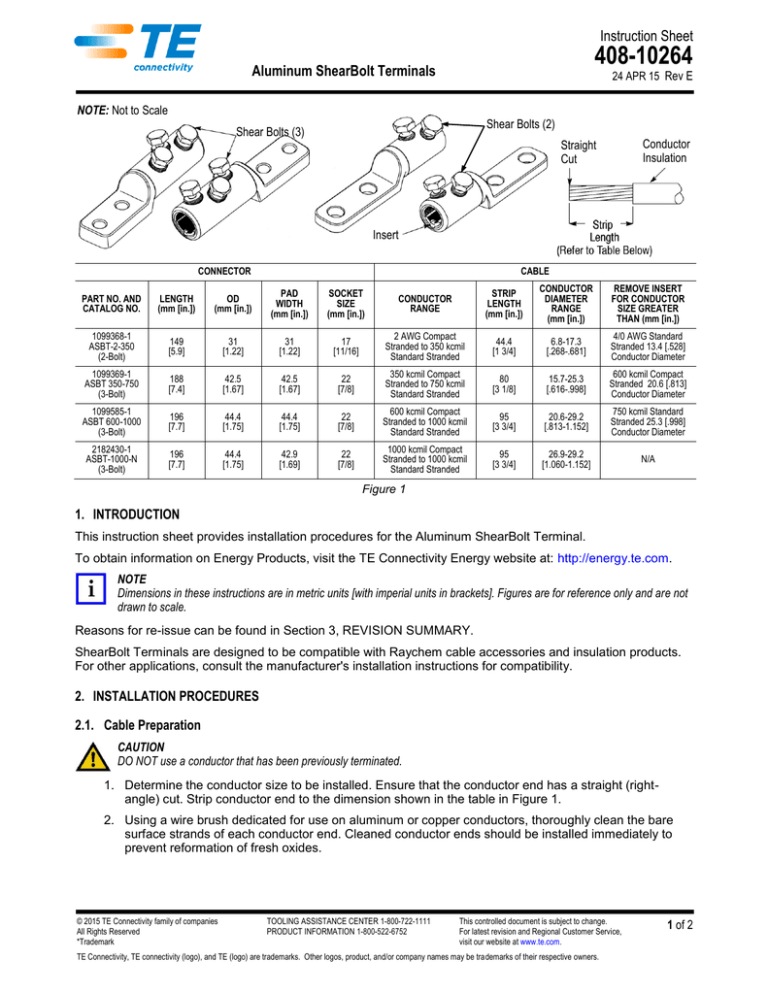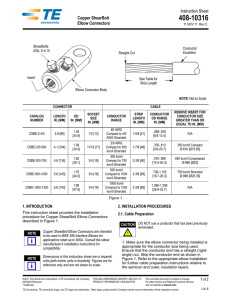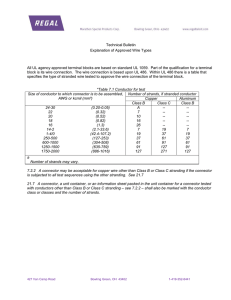
Instruction Sheet
408-10264
Aluminum ShearBolt Terminals
24 APR 15 Rev E
NOTE: Not to Scale
Shear Bolts (2)
Shear Bolts (3)
Conductor
Insulation
Straight
Cut
Insert
CONNECTOR
CABLE
PART NO. AND
CATALOG NO.
LENGTH
(mm [in.])
OD
(mm [in.])
PAD
WIDTH
(mm [in.])
SOCKET
SIZE
(mm [in.])
CONDUCTOR
RANGE
STRIP
LENGTH
(mm [in.])
CONDUCTOR
DIAMETER
RANGE
(mm [in.])
REMOVE INSERT
FOR CONDUCTOR
SIZE GREATER
THAN (mm [in.])
1099368-1
ASBT-2-350
(2-Bolt)
149
[5.9]
31
[1.22]
31
[1.22]
17
[11/16]
2 AWG Compact
Stranded to 350 kcmil
Standard Stranded
44.4
[1 3/4]
6.8-17.3
[.268-.681]
4/0 AWG Standard
Stranded 13.4 [.528]
Conductor Diameter
1099369-1
ASBT 350-750
(3-Bolt)
188
[7.4]
42.5
[1.67]
42.5
[1.67]
22
[7/8]
350 kcmil Compact
Stranded to 750 kcmil
Standard Stranded
80
[3 1/8]
15.7-25.3
[.616-.998]
600 kcmil Compact
Stranded 20.6 [.813]
Conductor Diameter
1099585-1
ASBT 600-1000
(3-Bolt)
196
[7.7]
44.4
[1.75]
44.4
[1.75]
22
[7/8]
600 kcmil Compact
Stranded to 1000 kcmil
Standard Stranded
95
[3 3/4]
20.6-29.2
[.813-1.152]
750 kcmil Standard
Stranded 25.3 [.998]
Conductor Diameter
2182430-1
ASBT-1000-N
(3-Bolt)
196
[7.7]
44.4
[1.75]
42.9
[1.69]
22
[7/8]
1000 kcmil Compact
Stranded to 1000 kcmil
Standard Stranded
95
[3 3/4]
26.9-29.2
[1.060-1.152]
N/A
Figure 1
1. INTRODUCTION
This instruction sheet provides installation procedures for the Aluminum ShearBolt Terminal.
To obtain information on Energy Products, visit the TE Connectivity Energy website at: http://energy.te.com.
NOTE
Dimensions in these instructions are in metric units [with imperial units in brackets]. Figures are for reference only and are not
drawn to scale.
Reasons for re-issue can be found in Section 3, REVISION SUMMARY.
ShearBolt Terminals are designed to be compatible with Raychem cable accessories and insulation products.
For other applications, consult the manufacturer's installation instructions for compatibility.
2. INSTALLATION PROCEDURES
2.1. Cable Preparation
CAUTION
DO NOT use a conductor that has been previously terminated.
1. Determine the conductor size to be installed. Ensure that the conductor end has a straight (rightangle) cut. Strip conductor end to the dimension shown in the table in Figure 1.
2. Using a wire brush dedicated for use on aluminum or copper conductors, thoroughly clean the bare
surface strands of each conductor end. Cleaned conductor ends should be installed immediately to
prevent reformation of fresh oxides.
© 2015 TE Connectivity family of companies
All Rights Reserved
*Trademark
TOOLING ASSISTANCE CENTER 1-800-722-1111
PRODUCT INFORMATION 1-800-522-6752
This controlled document is subject to change.
For latest revision and Regional Customer Service,
visit our website at www.te.com.
TE Connectivity, TE connectivity (logo), and TE (logo) are trademarks. Other logos, product, and/or company names may be trademarks of their respective owners.
1 of 2
408-10264
2.2. Connector Installation
1. Determine whether the insert should be removed according to conductor size (see Figure 1). If insert
removal is required, use a small screwdriver to lift or tap the insert from the connector body. DO NOT
remove the inhibitor contained inside the connector.
2. Back out all bolts to give clearance for the conductor in the connector body.
NOTE
Do not completely remove bolts from the connector body. Removing bolts followed by improper bolt re-installation could result
in stripping of the threads.
3. Insert the conductor into the connector body. For proper installation, there should be NO GAP
between the insulation and the connector body.
4. Tighten bolts in a three-step process:
a. Hand-tighten the bolts to firmly grip conductors in place. Follow the tightening sequence shown in
Figure 2.
b. Using a wrench with a hexagonal socket, tighten the bolts one to one-and-a-half turns, (one
second interval if using the TE Connectivity [cordless] impact wrench), repeating the sequence in
the previous step. Bolts should remain un-sheared. Prevent core bending by using Holding Tool
188072-000 (or equivalent) with the wrench as shown in Figure 2.
NOTE
Cordless Impact Wrench CA 7469-000 can be used instead for installation. A holding tool is not needed if using this wrench.
c. Repeat the sequence (above), tightening each bolt until the head of the bolt shears off. The wrench
should remain parallel to the connector body.
5. Smooth sharp edges of protruding bolts using the sandpaper provided. Clean connector to remove
particles.
6. For medium voltage applications, all bolt heads must be covered with the termination body to prevent
moisture ingress. For PILC applications, additional oil sealing components must be specified.
3. REVISION SUMMARY
Updated document to corporate requirements
Added new information to table in Figure 1.
Bolt Tightening Sequence
2-Bolt Connector
3-Bolt Connector
Wrench and Socket
Conductor
Cordless Impact Wrench
(CA 7469-000 Ref)
Holding Tool
188072-000 (Ref)
Figure 2
Rev E
2 of 2



